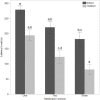Application of open field, tonic immobility, and attention bias tests to hens with different ranging patterns
- PMID: 31788364
- PMCID: PMC6882422
- DOI: 10.7717/peerj.8122
Application of open field, tonic immobility, and attention bias tests to hens with different ranging patterns
Abstract
Assessment of negative affective states is a key component of animal welfare research. In laying hens, excessive fearfulness results in reduced production and increased sensitivity to stress. Fearfulness can be defined as a response to a known threat, but anxiety is a response to an unknown threat and may have similar negative consequences. The open field test and tonic immobility test are commonly applied to measure fearfulness in laying hens. An attention bias test that measured individual hen's responses to playback of a conspecific alarm call in the presence of food was recently pharmacologically validated using an anxiogenic drug but was confounded by the hen's typical motionless response in a novel environment. The current study used 56-week old free-range layers to further assess the validity of an attention bias test to differentiate ranging treatment groups in comparison with the open field and tonic immobility tests. The selected hens varied in their range use patterns as tracked by radio-frequency identification technology. 'Indoor' hens did not access the range and 'outdoor' hens ranged daily; previous research has confirmed higher fearfulness in hens that remain indoors. The tonic immobility test did not differentiate ranging groups (P = 0.34), but indoor birds were slower to first step (P = 0.03) and stepped less (P = 0.02) in the open field test. The attention bias test occurred in an isolated wooden box using a conspecific alarm call playback (a threat) and mixed grain (a positive stimulus). The behavioural response of latency to resume eating following playback of the alarm call was measured to differentiate the anxiety states of the indoor and outdoor ranging birds. Before the attention bias test could occur, birds had to be habituated to the test box across three separate 5-minute sessions to increase the willingness to feed within the novel test environment. All birds ate faster across time (P < 0.001) but the indoor birds were slower to eat than the outdoor birds (P < 0.001). In this study, the latency to resume eating following an alarm call was determined to be a poor measure for highly anxious birds as they failed to eat at all. Forty-six percent of indoor hens were excluded for not eating across the 5-minute test. Of the birds that did eat, only 7% of indoor hens ate following playback of the alarm call, compared with 36% of outdoor hens. This repetition of an attention bias test for laying hens highlights the challenges in assessing hens with extreme fearful/anxious responses and that information may be missed when non-performing hens are excluded from behavioural tests. We suggest that latency to eat in a novel arena without any alarm call playback is an informative measure of anxious state that can be applied to all hens but consideration must be made of potential differences in food motivation.
Keywords: Affective state; Anxiety; Chicken; Fear; Free-range; Habituation; Latency; Vigilance; Welfare.
©2019 Campbell et al.
Conflict of interest statement
The authors declare there are no competing interests.
Figures


References
-
- Beauchamp G. External body temperature and vigilance to a lesser extent track variation in predation risk in domestic fowls. BMC Zoology. 2019;4:1. doi: 10.1186/s40850-019-0039-8. - DOI
-
- Brendler C, Kipper S, Schrader L. Vigilance and roosting behaviour of laying hens on different perch heights. Applied Animal Behaviour Science. 2014;157:93–99. doi: 10.1016/j.applanim.2014.06.004. - DOI
-
- Campbell DLM, Hinch GN, Downing JA, Lee C. Fear and coping styles of outdoor-preferring, moderate-outdoor and indoor-preferring free-range laying hens. Applied Animal Behaviour Science. 2016;185:73–77. doi: 10.1016/j.applanim.2016.09.004. - DOI
LinkOut - more resources
Full Text Sources
Research Materials
Miscellaneous

